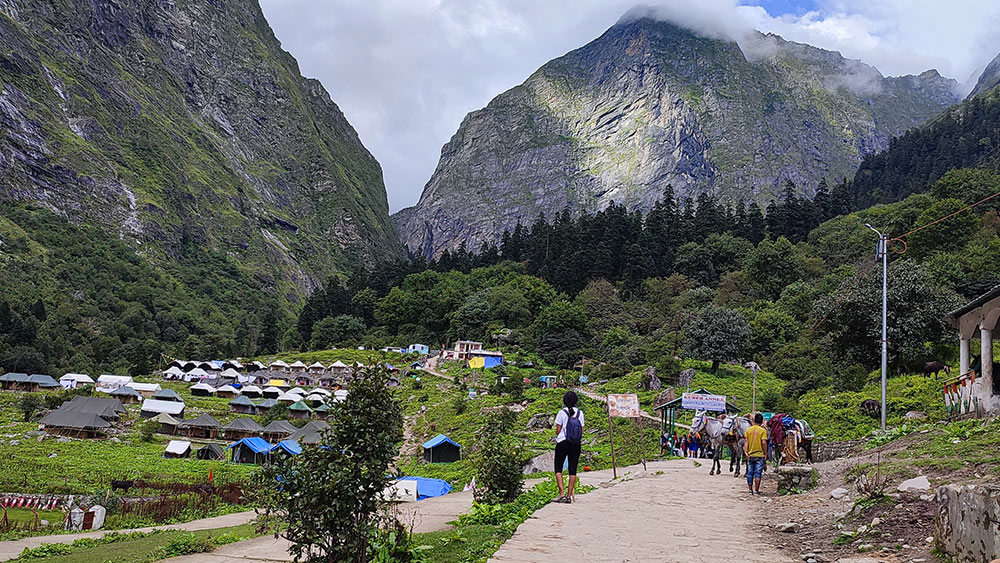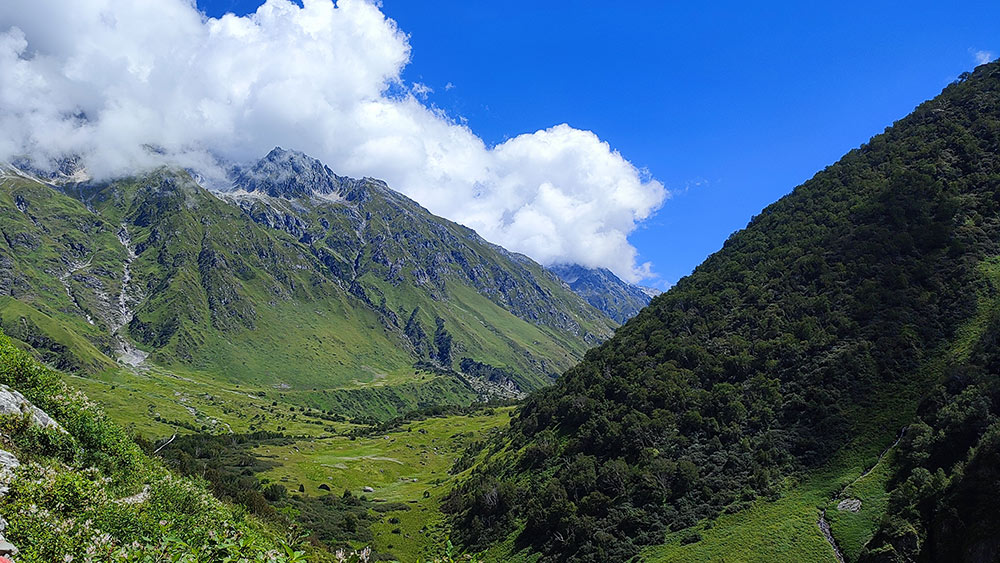Valley of Flowers Trek
Overview
Introduction of Valley of Flowers Trek
Myths and legends encountered reality when British mountaineers, Eric Shipton, Romilly Holdsworth, and Frank Smythe, got lost and reached the Valley of Flowers – a true paradise. They went for the famous Mount Kamet expedition and entered the Bhyundar Valley during their sensational descent. The trio discovered this particular valley instead of arriving in the Mana Village.
According to the Hindu folklore, the Valley of Flowers is believed to be the garden of Lord Indra. It is, therefore, often called Nandan Kanan. A high valley sculpted due to the glacial action of Pushpawati River, and running in the east-west direction along the river. The Pandavas named the river Pushpawati when they caught sight of flowers moving on the waters.
Read More
A huge snowclad ridge encompasses the Valley of Flowers. The valley is approximately 1 km wide and 5 km long. The elevation ranges between 3200 m and 3600 m. The entire region is filled with alpine vegetation from June to October. Tipra Glacier and Rataban Peak indicates the frontier of the valley. The Valley of Flowers National Park is a dream of botanists, photographers, ornithologists, and hikers. The valley is covered with white, pink, violet, and blue flowers during the monsoon season. Common examples include Anemone, Angelica, Balsam, Brahma Kamal, Forget Met Not, Blue Poppy, Marsh Marigold, Birch, and Cobra Lily. Pushpawati River flowing through the Valley of Flowers and Laxman Ganga coming from Hemkund Sahib joins at Ghangaria. From here, the river is called Bhyundar Ganga, and it meets Alaknanda at Govindghat. The path between Govindghat and Ghangaria is a long one. Now a motorable road is built till the Pulna Village. You can rent a car or share the one with fellow trekkers. The last climb is to the Helipad from Bhyundar Village. From here, Ghangaria is only a kilometre walk. Even though the walk to Ghangaria does not count for much, things change phenomenally after. The trail on the left side take you directly to the Valley of Flowers. The trail is spotless and there are no horses. You will visit the Hemkund Sahib next. If you do not wish to test your skills, please hire a horse. When you gain a tad altitude, you will see snow even in late July. At around 13000 feet, the terrain becomes rocky. Nestled in the Himalayan peaks, the Valley of Flowers is known for its incomparable natural beauty and floral diversity. The biome has around five hundred species of vascular plants and a hundred species of birds, mammals, and insects. You already know about the flowers in the Valley. Now it is time to focus on the fauna. The Valley of Flowers National Park along with the Nanda Devi National Park is perhaps the most bio-diversified region of the Himalayas. You may spot the snow leopards, Asiatic black bears, brown bears, musk deer, civet cats, and blue sheep. You may also observe colourful butterflies, bees, and moths. The birds include eagles, vultures, snowcocks, woodpeckers, magpies, robins, sunbirds, accentors, and rosefinches. Best Time to Visit The seasonal flowers begin to appear in the Valley in the month of June. Some flowers stay till September. You will come across a wide range of species when the monsoon sets in (July to August). So, it is best to visit during this time. Even if you take a trip in September, you can admire the green valley. What to Expect from Valley of Flowers Trek The Valley of Flowers Trek is suitable for beginners. Even though the whole trail length is longer than several easier treks, it is quite gentle, at least till the Bhyundar Village. The climb from the Bhyundar Village to Ghangaria is moderately steep. The climb to the Hemkund Sahib can be a bit challenging. You have to stay in lodges, which is considered convenient by most trekkers. You have to walk for 6-7 hours daily, so make sure to exercise and increase your physical stamina. If you do not wish to carry your backpack, offload it on the back of a horse. Since the Valley of Flowers is a Himalayan trek, be prepared for risks and uncertainties. But there is nothing you cannot handle. The below section will help trekkers understand what they can expect if having an adventure tour in the Valley of Flowers in monsoon. The Hemkund and Valley of Flowers are safe treks. The trail is manufactured from concrete – the type you get only in Pilgrim routes. During emergencies, you can opt for horse rides. Also, you can cover the trail on a helicopter. But helicopters will not fly during extreme weather. Monsoon brings lots of risks but flowers is why you travel in monsoon. Delays, hindrances, and unexpected situations are part of all treks. For instance, minor landslides can block the road for many hours. Also, if it starts raining, you will not be allowed to enter the Valley. So, adding another buffer day makes sense. To conclude, even with all the risks, the Valley of Flowers is the safest trek.
Tour Information
Regions
Trek Grade
Trek Length
Altitude
ITINERARY

Duration: 10 Hours
Distance: 300 Km
The journey to the Valley of Flowers starts at Haridwar. The one-day road trip will help you admire multiple emerald rivers. Lunch is organised by your guide. Located at the bank of Alaknanda River. Govindghat is perhaps the beginning point of the Valley of Flowers trek. Enjoy the beautiful scenes around. Take rest for the journey next day. Rishikesh is the nearest railway station – 270 km away from Govindghat. Dehradun is the nearest airport – 300 km away from Govindghat.

Duration: 6 Hours
Distance: 14 km
Try leaving immediately after breakfast. You have to start your trek by 8 am to reach the Ghangaria Village at a desired time. The whole route is filled with picturesque locale, from small lakes to calming waterfalls. The path generally winds around Lakshman Ganga River. Ghangaria is an important stopover. The travellers can go for nature walks, and dig into the wilderness around. Please use bamboo sticks to trek from Govindghat and reach the Ghangaria Village.

Duration: 2 Hours
Distance: 3 km
On the third day, you have to trek to the Valley of Flowers. Get ready for a short climb, aesthetically appealing landscapes, and moderate gradient. At first, the Rataban peak will welcome you. On the lefthand side, you will see the Nar Parvat, and on the righthand side is the deep birch forest.
The Valley of Flowers is an integral part of Nanda Devi National Park and Reserve, which lies in the UNESCO recognised biosphere reserves. Seven out of ten trekkers have the Valley on their bucket list. The panoramic views of Himalayas will surely leave a profound impact on your heart.
The urban cacophony has taken a serious toll on all our lives. A trek to the Valley of Flowers is perfect for people who love peace and solitude. The fragrance of flowers, chirping of birds, and refreshing air blend together to make everything memorable. The cherry on the cake is there is zero pollution out here.
Head back to Ghangaria that day.

Duration: 3 Hours
Distance: 6 km
Leave for Hemkund Sahib early. A gorgeous lake and snowclad mountains make this place spiritual as well as serene. Blue Poppy and Brahma Kamal are the rarest species of flowers you will find here. Expect the steepest climbs. Once you reach Hemkund Sahib, please soak as much beauty you can. Relish hot tea at the Gurudwara. Also, pay a visit to the Laxman Mandir. Head back after having lunch.

Duration: 6 Hours
Distance: 14 km
On the fifth day, you have to trek to Govindghat. Lying on the banks of Alaknanda River and with Neelkanth Peak in the background, this holy place is the perfect destination for people into spirituality. On your way, you have to cross sulphur pools and breath the unpolluted air. Move back to your lodge and take rest.
Duration: 10 Hours
Distance: 300 km
After having breakfast, please head back to Haridwar from Govindghat. Your trek to the Valley of Flowers ends here.
You can customise your tour package. The fees depend on the kind of accommodation and group size. Generally, you have to pay around Rs.9800 along with 5% GST. The trekking organisation will arrange transportation from Haridwar to Govindghat and back. Meals provided are nutritious, tasty, and vegetarian. You are given insurance for hospitalisation and evacuation. The policy covers your itinerary of a week.
Inclusion
- Transport support from Haridwar to Govindghat and same for return.
- All meals starting from dinner on day 1 to breakfast on day 6
- Professional mountain guide, professional cook, experienced staffs
- Basic first aid kits
- Forest Department’s charges
- Guest houses and hotels accommodations throughout the trip on a triple sharing basis.
Exclusion
- 5% GST on trek cost
- Transport to reach Haridwar from hometown and return
- Accommodation in Haridwar
- Any transport support during the trip other than those specified in Inclusions
- Any expenses for medical treatment of injury or accident before, during or after the journey
- Food items purchased by individuals at local canteens on the trek or during the drive
- Any early return travel costs or accommodation except for the days as per the itinerary
- Package excludes porter/mule charges for personal luggage
- Any cost arising due to unforeseen events like bad weather, roadblocks, medical evacuation, etc
Tour Amenities
Trip Policy
- Booking can be done by online-bank transfer and UPI in company’s account.
- Booking amount is 30% of total trek fee.
- 30 Days or more before date of departure: 30% of total cost.
- 20 days before date of departure: 100% of total cost.
Before departure from starting point(as mentioned in our tour package), if a trip is called off from our side due to a natural calamity/unforeseen circumstances (like rains, snowfall, earthquake, landslides, strike etc.), full paid amount will be refunded.
In case you wish to cancel your trip, kindly send us an email info@detouradventures.com
Cancellation charges per person
- Cancel before 30 days of trek start date and get refund after deduction of 5% on booking amount
- Cancel before 20 days of trek start date and get refund after deduction of 15% of total trek fee.
- Cancel before 10 days of trek start date and get refund after deduction of 40% of total trek fee.
- Trek fee is non-refundable if you cancel within 9 days before trek start date.
- Trek fee is non-refundable if a trek is called off due to a natural calamity after departure from the starting point.








